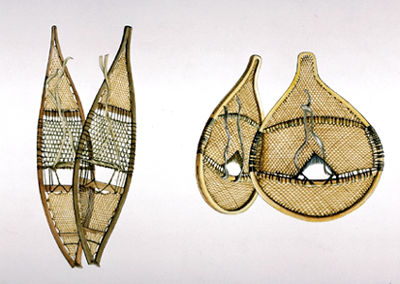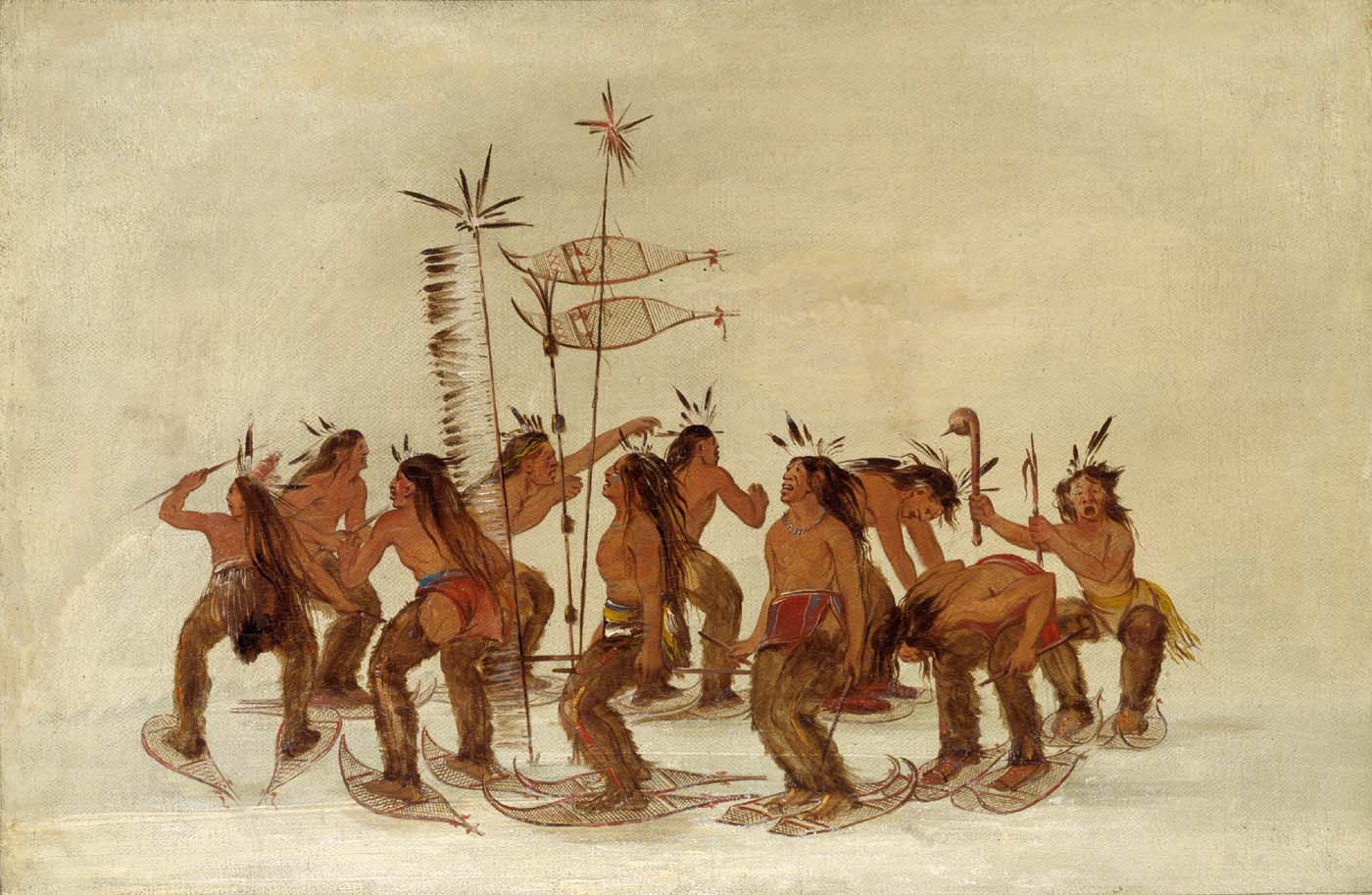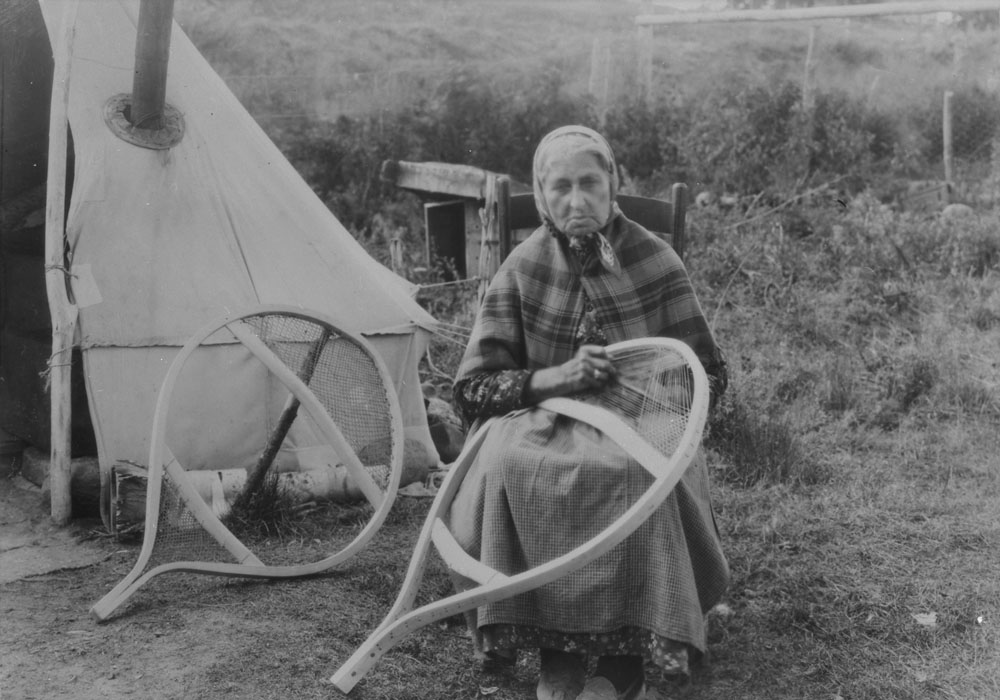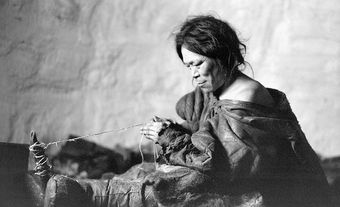Snowshoes are footwear that help to distribute the weight of a person while they walk over deep snow, preventing them from sinking too far into the snow with every step. In the past, Indigenous peoples used snowshoes for winter travel in Canada, outside the Pacific and Arctic coasts. Snowshoeing has since become a popular Canadian pastime, enjoyed by hikers and sportspeople.
What Are Snowshoes?
A snowshoe is a piece of footwear that resembles a racquet and that is attached to and worn underneath a pair of boots or winter shoes. In the past, Indigenous peoples, fur traders and early settlers typically attached moccasins to snowshoes.
Historically, Indigenous peoples throughout most of Canada made and used snowshoes to travel on foot during the winter. Snowshoes enabled them to walk over knee-deep snow and to hunt without making much noise. During the fur trade, voyageurs, explorers and traders quickly adopted the snowshoe, as well as other Indigenous tools and clothing, to make travelling and working in the winter easier.
How Are Snowshoes Made?
The traditional snowshoe-making process usually took several days. Before making the snowshoes, Indigenous peoples first had to harvest the right type of wood for the frames and animal for the hide and babiche (string made of rawhide). Frames were generally made of durable, flexible ash or birch wood. The wood was steamed or soaked in water to make it pliable during construction.
Snowshoes were then laced, using deer, caribou and moose hide. The toe and tail sections of the shoe were laced with a light babiche and the central body with a heavy babiche for better weight suspension. Leather or rawhide straps secured moccasins to the device. At times, snowshoes were decorated with special charms that carried cultural significance.
While some snowshoes are still made by hand, this is generally a rarity; most snowshoes are now mass-manufactured and feature aluminum frames and steel cleats. Today, traditional wooden and hide snowshoes are considered works of art, featured in many cultural centres and museums across North America. (See also History of Indigenous Art in Canada.)
Did You Know?
In 1758, during the Seven Years’ War, the French defeated the British in the Battle on Snowshoes near Lake George in present-day New York state. The loss made the British realize the effectiveness of snowshoes during military campaigns in the Canadian winter.
Types of Snowshoes
Traditionally, snowshoes differed in size and shape depending on the use of the shoe and on its maker. Long and tear-shaped snowshoes, sometimes known as the swallowtail model, were used by the northern Cree during months when the snow was heavy. Beavertail models, also used by northern Cree peoples, were wide around the foot with an upturned toe and narrow tail. They worked well in open woodlands and areas of rolling terrain. Bearpaw snowshoes, which were lightweight and circular in shape, were ideal for climbing and walking in mountainous or densely wooded areas. Innu and some Cree peoples used the bearpaw model. The Innu also used the Montagnais/Innu snowshoe, which was round and wide, and made for deep snow.
The snowshoe designs perfected by Indigenous peoples still inspire modern models. As in the past, snowshoes today vary in size and function, depending on their purpose. Snowshoes for flat terrain, for example, have moderate traction and are ideal for use in Eastern and Central Canada. Mountainous, icy terrain, such as that in Western Canada, requires snowshoes with tiny spikes (crampons) for better traction. Snowshoes designed for rolling terrain have less aggressive crampons for traction. Running snowshoes for athletes and outdoor enthusiasts are narrow and asymmetrical in shape so as to allow for fast movement on packed snow.
Cultural Significance
The snowshoe, rooted in Indigenous technology and ingenuity, is now often considered a symbol of Canadian identity and culture. The snowshoe has allowed for Canadians to not only survive the snowy and icy terrain, but to enjoy it. Since the mid-1800s, snowshoeing has become a popular sporting and recreational activity among Canadians. Snowshoeing also retains its practical value to hunters in various parts of the country.

 Share on Facebook
Share on Facebook Share on X
Share on X Share by Email
Share by Email Share on Google Classroom
Share on Google Classroom












